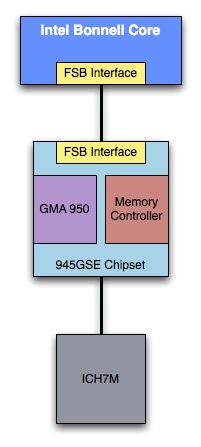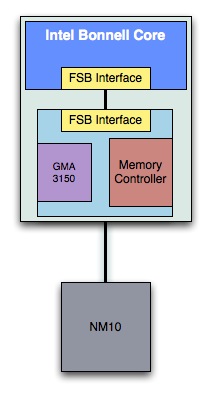Intel Unveils Moorestown and the Atom Z600, The Fastest Smartphone Platform?
by Anand Lal Shimpi on May 4, 2010 11:54 PM EST- Posted in
- Smartphones
- Intel
- Atom
- Mobile
- SoCs
The World Changes, MIDs Ahead of Their Time
Silverthorne lacked integration, which wasn’t a problem for MIDs and netbooks, but it kept the chip out of smartphones. Between 2004 and Atom’s introduction in 2008 the iPhone happened. All of the sudden the clunky MIDs we were reluctantly waiting for stopped being interesting. What we wanted were more iPhones, and iPhone clones. Then came Android and the rest is history. While Atom had tremendous success in netbooks, Intel’s decision to pursue a discrete route first kept it out of smartphones.
Luckily, next on the list after the first Atom was a more integrated one with the goal of dropping power consumption. We saw this with Pine Trail, the netbook Atom that brought the memory controller and GPU on-die. Performance didn’t improve because unlike most integrated memory controllers, this one still connected to the CPU via a FSB.
Intel Atom "Diamondville" Platform 2008 |
Intel Atom "Pine Trail" Platform 2009-2010 |
 |
 |
Pine Trail still has all of the bells and whistles of a PC platform however. Take the PCI bus for example. Every 12 microseconds it wakes up and polls every IO on the platform. That kills idle battery life, especially when you’ve got a tiny smartphone battery. Pine Trail is useless for smartphones, and that’s where Moorestown comes in.
If you thought this was the netbook Atom squeezed into a smartphone, you’re very wrong. It’s got a completely different memory controller, a true smartphone GPU (the same core, but clocked higher than what’s in the iPhone 3GS) and a ton of power optimizations that just don’t exist in the netbook version. The chipset is also very different. The PCI bus is gone as is anything that could ruin power consumption. Intel did a lot of optimization and a lot of cutting here. What resulted is something that looks a lot like a smartphone hardware platform and nothing like what we’re used to seeing from Intel.
This is Moorestown.










67 Comments
View All Comments
teohhanhui - Thursday, May 6, 2010 - link
But they'll be showcasing it on their Moblin/Meego which is Linux. Won't shoot themselves in the feet, will they?rahvin - Thursday, May 6, 2010 - link
And if it only runs on Moblin, only with specific kernel versions, uses a binary blob driver and isn't maintained it will be the same story as GMA500 all over again.strikeback03 - Thursday, May 6, 2010 - link
As pointed out, plenty of other Android phones are using the same graphics. And I haven't heard a lot of complaints about lack of drivers for the Droid/N1/etc.elisha.pan - Wednesday, May 5, 2010 - link
GMA500 has nothing with the Intel GMA series, but name. It is exactly the same with PowerVR SGX 535.DanNeely - Wednesday, May 5, 2010 - link
This is the same GPU used in almost every other smart phone on the market, except that it's designed to be clocked up to twice as fast. It's not going to run Crysis *rolls eyes* but it's more than capable of doing everything a smart phone/internet tablet will need to do.ekul - Wednesday, May 5, 2010 - link
exactly. without open source drivers for the graphic any development of meego outside of intel will never go anywhere. One of the reasons I bought my current netbook is the gma 950 has excellent open source drivers that just work.Open source development moves fast. Closed source binaries get left behind because they can't keep up with the release schedule. The current gma 500 drivers already need a kernel several versions old as well as an old X server. How many releases is meego going to miss?
ViRGE - Wednesday, May 5, 2010 - link
I can see why Anand thinks it's an interesting product, but based on his article I don't think Intel is quite there.The current need for 5 chips is going to be a problem no matter how Intel dresses things up, and if all phones end up looking like the design shown I wouldn't be surprised if the consumer reaction was tepid - a phone of that size is still pretty big. The video playback time is also going to be a problem when it comes to spec sheets (I doubt the real-world impact will be as huge), but OEMs like their spec sheets and consumers aren't too far off either. Just looking like it'll perform poorly there may be enough.
The other issue is the reliance on an OS. At this point it seems like no one really wants another OS. Most people around here seemed to be more relieved than concerned when Palm went under. With BlackBerryOS, IPhoneOS, Android, and WinCE, there seems to be as many OSes as the market can reasonably handle. Moblin/MeeGo may be necessary for the hardware right now, but I see no reason to expect that it's going to be properly developed for consumer use like the above OSes were. Unless Intel can land RIM/Apple, they need to get Android up to par on Moorestown and they need to do it yesterday.
Ultimately I think it's going to Medfield that's a proper ARM competitor. With fewer chips it will fit in to traditional designs, and with any luck Intel will be a node ahead of its competition on the manufacturing process. It won't solve the current OS reliance, but it'll put them in a better position than Moorestown does.
ET - Wednesday, May 5, 2010 - link
Ultimately I think that most people don't care about the OS. The OS mainly matters in terms of applications available for it, and it's a pain for developers to address many OS's, but also an opportunity for new developers to carve their niche.That said, Anand did mention that Intel is making Android available for this new platform, which should be good enough.
IntelUser2000 - Wednesday, May 5, 2010 - link
It's much closer than expected. There were quite frequent comments that thought it wouldn't even reach 5 hour on standby! Having a lot of knowledge and doing a bit research helps of course. Glad they can be roughly on par though.It's likely the idle power can't be achieved without optimized OSes. Even if you can run Windows on it, what's the point when you won't have the battery life for it? Windows uses too much on keeping legacy support and its too bloated for idle power under 50mW.
Platform approach is the key to low power on Moorestown.
piroroadkill - Wednesday, May 5, 2010 - link
I'm not sold. ARM has been more efficient for a lot longer, even though it's still being made on commonly larger processes than current Intel CPUs. All smartphones are ARM anyhow, so I don't see the advantage in having x86 in this space